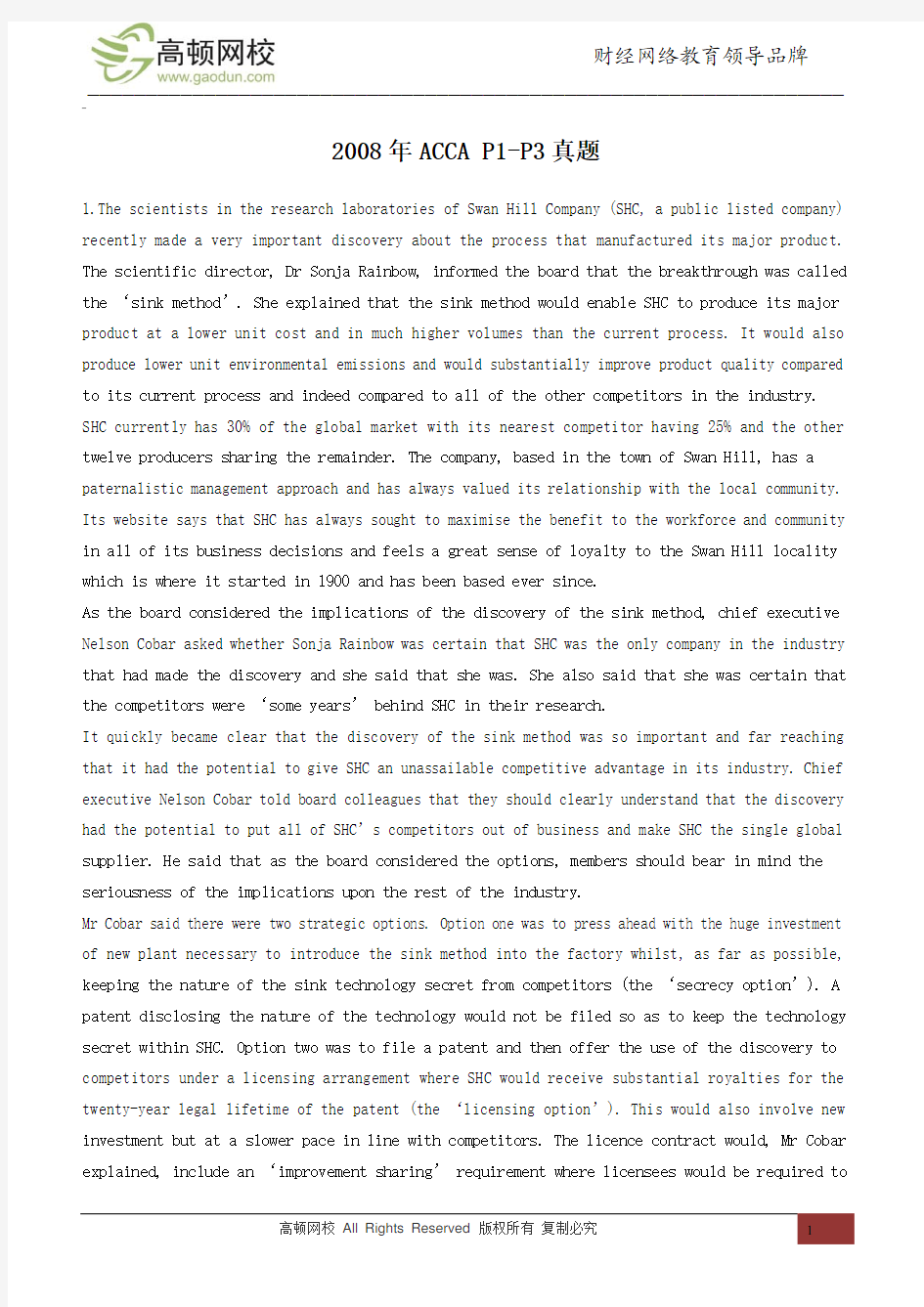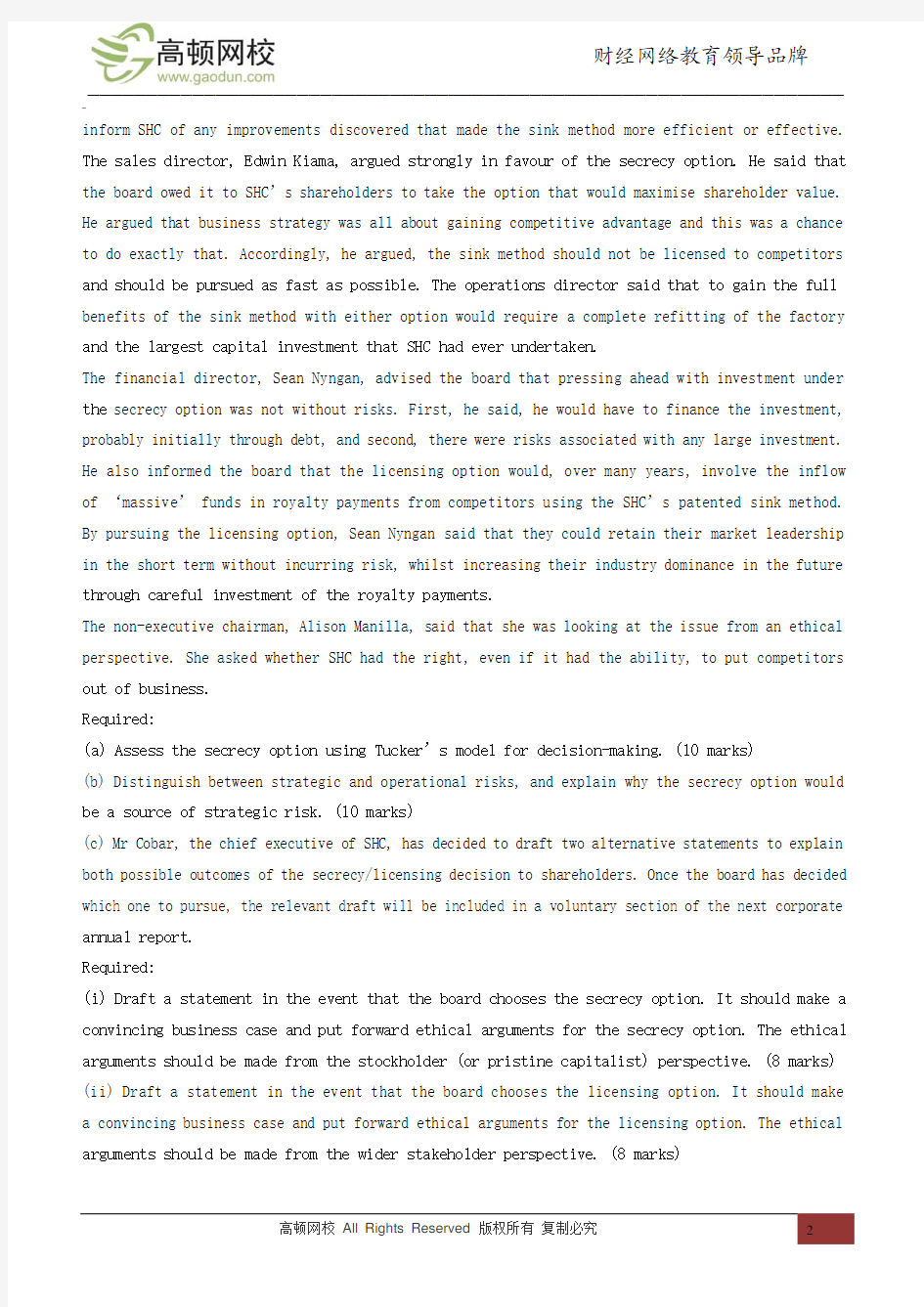2008年ACCAP1-P3真题


2008年ACCA P1-P3真题
1.The scientists in the research laboratories of Swan Hill Company (SHC, a public listed company) recently made a very important discovery about the process that manufactured its major product. The scientific director, Dr Sonja Rainbow, informed the board that the breakthrough was called the ‘sink method’. She explained that the sink method would enable SHC to produce its major product at a lower unit cost and in much higher volumes than the current process. It would also produce lower unit environmental emissions and would substantially improve product quality compared to its current process and indeed compared to all of the other competitors in the industry. SHC currently has 30% of the global market with its nearest competitor having 25% and the other twelve producers sharing the remainder. The company, based in the town of Swan Hill, has a paternalistic management approach and has always valued its relationship with the local community. Its website says that SHC has always sought to maximise the benefit to the workforce and community in all of its business decisions and feels a great sense of loyalty to the Swan Hill locality which is where it started in 1900 and has been based ever since.
As the board considered the implications of the discovery of the sink method, chief executive Nelson Cobar asked whether Sonja Rainbow was certain that SHC was the only company in the industry that had made the discovery and she said that she was. She also said that she was certain that the competitors were ‘some years’ behind SHC in their research.
It quickly became clear that the discovery of the sink method was so important and far reaching that it had the potential to give SHC an unassailable competitive advantage in its industry. Chief executive Nelson Cobar told board colleagues that they should clearly understand that the discovery had the potential to put all of SHC’s competitors out of business and make SHC the single global supplier. He said that as the board considered the options, members should bear in mind the seriousness of the implications upon the rest of the industry.
Mr Cobar said there were two strategic options. Option one was to press ahead with the huge investment of new plant necessary to introduce the sink method into the factory whilst, as far as possible, keeping the nature of the sink technology secret from competitors (the ‘secrecy option’). A patent disclosing the nature of the technology would not be filed so as to keep the technology secret within SHC. Option two was to file a patent and then offer the use of the discovery to competitors under a licensing arrangement where SHC would receive substantial royalties for the twenty-year legal lifetime of the patent (the ‘licensing option’). This would also involve new investment but at a slower pace in line with competitors. The licence contract would, Mr Cobar explained, include an ‘improvement sharing’ requirement where licensees would be required to
inform SHC of any improvements discovered that made the sink method more efficient or effective. The sales director, Edwin Kiama, argued strongly in favour of the secrecy option. He said that the board owed it to SHC’s shareholders to take the option that would maximise shareholder value. He argued that business strategy was all about gaining competitive advantage and this was a chance to do exactly that. Accordingly, he argued, the sink method should not be licensed to competitors and should be pursued as fast as possible. The operations director said that to gain the full benefits of the sink method with either option would require a complete refitting of the factory and the largest capital investment that SHC had ever undertaken.
The financial director, Sean Nyngan, advised the board that pressing ahead with investment under the secrecy option was not without risks. First, he said, he would have to finance the investment, probably initially through debt, and second, there were risks associated with any large investment. He also informed the board that the licensing option would, over many years, involve the inflow of ‘massive’ funds in royalty payments from competitors using the SHC’s patented sink method. By pursuing the licensing option, Sean Nyngan said that they could retain their market leadership in the short term without incurring risk, whilst increasing their industry dominance in the future through careful investment of the royalty payments.
The non-executive chairman, Alison Manilla, said that she was looking at the issue from an ethical perspective. She asked whether SHC had the right, even if it had the ability, to put competitors out of business.
Required:
(a) Assess the secrecy option using Tucker’s model for decision-making. (10 marks)
(b) Distinguish between strategic and operational risks, and explain why the secrecy option would be a source of strategic risk. (10 marks)
(c) Mr Cobar, the chief executive of SHC, has decided to draft two alternative statements to explain both possible outcomes of the secrecy/licensing decision to shareholders. Once the board has decided which one to pursue, the relevant draft will be included in a voluntary section of the next corporate annual report.
Required:
(i) Draft a statement in the event that the board chooses the secrecy option. It should make a convincing business case and put forward ethical arguments for the secrecy option. The ethical arguments should be made from the stockholder (or pristine capitalist) perspective. (8 marks) (ii) Draft a statement in the event that the board chooses the licensing option. It should make a convincing business case and put forward ethical arguments for the licensing option. The ethical arguments should be made from the wider stakeholder perspective. (8 marks)
(iii) Professional marks for the persuasiveness and logical flow of arguments: two marks per statement.
(4 marks)
(d) Corporate annual reports contain both mandatory and voluntary disclosures.
Required:
(i) Distinguish, using examples, between mandatory and voluntary disclosures in the annual reports of public listed companies. (6 marks)
(ii) Explain why the disclosure of voluntary information in annual reports can enhance the company’s accountability to equity investors. (4 marks)
(50 marks) Section B – TWO questions ONLY to be attempted
2.Hogg Products Company (HPC), based in a developing country, was recently wholly acquired by American Overseas Investments (AOI), a North American holding company. The new owners took the opportunity to completely review HPC’s management, culture and systems. One of the first things that AOI questioned was HPC’s longstanding corporate code of ethics.
The board of AOI said that it had a general code of ethics that HPC, as an AOI subsidiary, should adopt. Simon Hogg, the chief executive of HPC, disagreed however, and explained why HPC should retain its existing code. He said that HPC had adopted its code of ethics in its home country which was often criticised for its unethical business behaviour. Some other companies in the country were criticised for their ‘sweat shop’ conditions. HPC’s adoption of its code of ethics, however, meant that it could always obtain orders from European customers on the guarantee that products were made ethically and in compliance with its own highly regarded code of ethics. Mr Hogg explained that HPC had an outstanding ethical reputation both locally and internationally and that reputation could be threatened if it was forced to replace its existing code of ethics with AOI’s more general code.
When Ed Tanner, a senior director from AOI’s head office, visited Mr Hogg after the acquisition, he was shown HPC’s operation in action. Mr Hogg pointed out that unlike some other employers in the industry, HPC didn’t employ child labour. Mr Hogg explained that although it was allowed by law in the country, it was forbidden by HPC’s code of ethics. Mr Hogg also explained that in his view, employing child labour was always ethically wrong. Mr Tanner asked whether the money that children earned by working in the relatively safe conditions at HPC was an important source of income for their families. Mr Hogg said that the money was important to them but even so, it was still wrong to employ children, as it was exploitative and interfered with their education. He also said that it would alienate the European customers who bought from HPC partly on the basis
of the terms of its code of ethics.
Required:
(a) Describe the purposes and typical contents of a corporate code of ethics. (9 marks)
(b) ‘Strategic positioning’ is about the way that a company as a whole is placed in its environment and concerns its ‘fit’ with the factors in its environment.
With reference to the case as appropriate, explain how a code of ethics can be used as part of a company’s overall strategic positioning. (7 marks)
(c) Assess Mr Hogg’s belief that employing child labour is ‘always ethically wrong’ from deontological and teleological (consequentialist) ethical perspectives. (9 marks)
(25 marks)
Section A – This ONE question is compulsory and MUST be attempted
3.Warrburt’s directors are concerned about the results for the year in the statement of comprehensive income and the subsequent effect on the cash flow statement. They have suggested that the proceeds of the sale of property, plant and equipment and the sale of available-for-sale financial assets should be included in ‘cash generated from operations’. The directors are afraid of an adverse market reaction to their results and of the importance of meeting targets in order to ensure job security, and feel that the adjustments for the proceeds would enhance the ‘cash health’ of the business.
Required:
(a) Prepare a group statement of cash flows for Warrburt for the year ended 30 November 2008 in accordance with IAS7, ‘Statement of Cash Flows’, using the indirect method. (35 marks)
(b) Discuss the key issues which the statement of cash flows highlights regarding the cash flow of the company.
(10 marks)
(c) Discuss the ethical responsibility of the company accountant in ensuring that manipulation of the statement of cash flows, such as that suggested by the directors, does not occur. (5 marks) Note: requirements (b) and (c) include 2 professional marks in total for the quality of the discussion.(50 marks)
Section B – TWO questions ONLY to be attempted
参与ACCA考试的考生可按照复习计划有效进行,另外高顿网校官网ACCA考试辅导高清课程已经开通,还可索取ACCA考试通关宝典,针对性地讲解、训练、答疑、模考,对学习过程进行全程跟踪、分析、指导,可以帮助考生全面提升复习备考效果。更多详情可登录高顿网校官网或关注高顿网校微信咨询。
